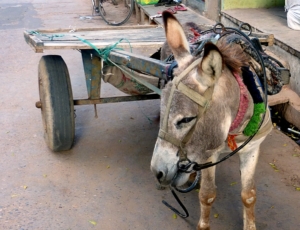5 Things to Know about the Brooke Charity
 Around the world, over 100 million working horses, donkeys and mules, provide invaluable support to nearly eight percent of the world’s population. Through transportation, haulage and production, healthy working horses, donkeys and mules help put food on the table, send children to school and build better futures for their families. The Brooke charity has made it their mission to look out for these unsung heroes of poverty-ridden communities. Here are five things to know about the Brooke charity:
Around the world, over 100 million working horses, donkeys and mules, provide invaluable support to nearly eight percent of the world’s population. Through transportation, haulage and production, healthy working horses, donkeys and mules help put food on the table, send children to school and build better futures for their families. The Brooke charity has made it their mission to look out for these unsung heroes of poverty-ridden communities. Here are five things to know about the Brooke charity:
What is Brooke?
According to their website, “Brooke is an international animal welfare charity dedicated to improving the lives of working horses, donkeys and mules.” With operations in Africa, Asia, Latin America and the Middle East, they reach over two million working horses, donkeys and mules across the globe. Their staff of over 900 people consists of vets, animal welfare experts and development specialists.
What do they do?
Brooke protects and improves the lives of equines that bolster the livelihoods of some of the world’s poorest communities. Animals cannot better their own welfare but people can. Brooke works with communities to provide the skills and support necessary to unlock their compassion for animals and reap the benefit it brings to their livelihoods. The charity partners with local health services and farriers to strengthen the skills of owners so they can get their animals the help they need timely and effectively. Brooke provides support for long-lasting change by working with international bodies such as the U.N. and governments at all levels.
How has Brooke evolved?
In 1930, when Dorothy Brooke arrived in Egypt, she was appalled at the state of the ex-warhorses being sold into a life of hard labor at the conclusion of World War I. Within three years, Dorothy Brooke had purchased 5,000 ex-warhorses. Most were old, exhausted and had to be humanely put down though, thanks to her, they ended their lives peacefully.
Brooke knew many hard-working horses, donkeys and mules still suffered. In 1934, she founded the Old War Horse Memorial Hospital in Cairo to provide free veterinary care for all the city’s working equines. Thus, the Brooke Hospital for Animals was born.
Fast forward 85 years to the present time, when Brooke leads the way in providing help to working equines and their owners in the developing world. They met their goal to reach two million working horses, donkeys and mules in 2016 in 11 countries, and continue to strive for greater impact around the world.
Why does their work matter?
Working equines transport people, move goods and deliver food and water. In some countries, up to six people rely on a single animal for survival. This means that in many of the world’s poorest regions, human welfare is inextricably linked to the welfare of working horses, donkeys, and mules. A healthier animal enables its owner to increase their income and improve living conditions. Given that approximately 80 percent of animal suffering is preventable, Brooke is doing all they can to ensure well-fed and looked after working animals can continue to keep millions of people out of extreme poverty.
What are the potential weaknesses of this organization?
While traditional working equine welfare programs have had some success in improving welfare and alleviating poverty, they have significant drawbacks. Providing vet or farrier care is expensive, can lead to a culture of dependency and often fails to reach all members of a community. Outreach education work can increase awareness but does not always create the behavioral changes needed for stable incomes and sustainable animal welfare.
Developing communities that depend on equines can largely benefit from the improved standards of living delivered by simple, effective programs that promote animal welfare at the community level. With a new or better understanding of the needs of their horses, donkeys or mules, people are empowered to change their behaviors and sustainably increase their income. This contributes to any developing community’s ultimate goal: a movement out of poverty.
– GiGi Hogan
Photo: Flickr
